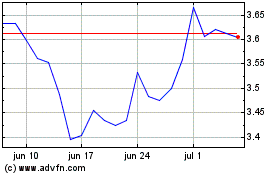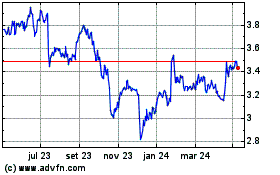Telco industry sees AI as key to cutting energy demand from rising internet traffic – Nokia/GSMA research
02 Novembro 2021 - 3:00AM

Telco industry sees AI as key to cutting energy demand from rising
internet traffic – Nokia/GSMA research
Press Release
Telco industry sees AI
as key to
cutting energy demand
from rising
internet traffic –
Nokia/GSMA research
- GSMA Intelligence surveyed 103
communication service providers (CSPs), around a quarter of CSPs
globally, on a variety of energy efficiency issues
- Research found that CSPs
overwhelmingly view rising energy demand and costs as critical
issues to their operations and their customers
- Nokia and GSMA Intelligence also
announced a separate white paper that estimates the four top
carbon-emitting industries, which are responsible for 80% of global
emissions, can enable and accelerate a reduction in carbon
emissions through the widescale implementation of mobile and
digital technologies, particularly over the next 10 years
2 November 2021
Espoo, Finland – Nokia and GSMA
Intelligence today announced new research showing that
communication service providers (CSPs) around the
world believe that
deploying artificial intelligence (AI)
software is
essential to
reducing fast-rising
network energy demand and
emissions,
spurred by
internet traffic
growth.
With the United Nations’ COP26 climate change conference
proceeding in Scotland where world leaders are working to reach a
global emissions deal, most CSPs surveyed in the research said that
energy efficiency is either “very important” or “extremely
important” in their network transformation strategy to counter
rising energy consumption and emissions.
Along with the use of renewables, AI energy management software
is central to many CSP strategies to shrink their environmental
footprint, due to those solutions’ ability to be used quickly and
effectively across an entire network with little to no human
intervention.
GSMA Intelligence, an industry authority on global mobile
operator data, insights, reports and forecasts, found that 83% of
CSPs surveyed see energy efficiency as a major network
transformation driver that will grow in importance as 5G is
operationalized by industry; while 67% expect their energy costs to
rise over the next three years based on current trends.
Global internet traffic has risen exponentially in recent years
due to a convergence of factors like increased television and movie
streaming, video conferencing from remote working, and online
gaming as 4G and now 5G become a larger share of the mobile
customer base. Such activities require more energy consuming telco
equipment and bandwidth capacity, as well as large amounts of data
stored in an ever growing number of energy consuming data centers.
As businesses and enterprises tap advanced 5G services, like
network slicing, further demands will be made on telco networks,
data centers, and energy consumption.
Many CSP respondents acknowledged they are still in the early
planning and testing stages of getting their AI efforts off the
ground with respect to energy efficiency. Still, nearly 50% of CSP
respondents said they expect to achieve energy savings of 10% to
20% over the next two years as AI energy solutions are rolled out
and optimized.
Using zero-touch automation, AI programs can improve energy
savings by closely aligning equipment usage patterns with real-time
network demands; and identifying performance anomalies in
underperforming network equipment that saps energy resources and
requires replacement.
Beyond curtailing energy demand, AI-powered energy solutions are
expected to drive other important outcomes, such as reducing the
number of on-site visits personnel have to make to troubleshoot
network issues.
The separate white paper by Nokia and GSMA
Intelligence projects that the implementation of mobile and
digital technologies, like 5G, 4G, private
networks, and IoT sensors, could catalyze large carbon
emission savings in manufacturing, power and energy,
transportation, and buildings; all of which account for
around 80% of
global carbon emissions.
For example, annual manufacturing carbon savings
from the rollout of smart factories at scale could
save the equivalent of 28 million roundtrip flights from London to
Los Angeles in a year;
while energy savings from the widespread use
of smart meters in homes, by more efficiently using
resources when they are actually needed, would be enough to
power 97 million homes in a year.
Volker Held, Head of
Marketing for Managed Services,
Cloud & Network Services at
Nokia, said:
“Reducing its carbon footprint is an important challenge for the
telecommunications industry, given rising internet traffic trends
and its implications for energy consumption. This research from
Nokia and GSMA underscores the shared concerns of our industry and
the variety of solutions and services that Nokia is working on with
communication service providers to address this shared
responsibility. AI solutions hold the promise of realizing quick
and substantial energy efficiency gains and ensure we fully live up
to our environmental and social responsibilities.”
Tim Hatt, Head of Research and Consulting
at GSMA Intelligence, said: “AI
has clear and tangible benefits to improving the energy efficiency
of telecom networks and is a big part of the solution in driving
sustainable 5G networks. It’s important to deploy AI early in order
to train the algorithms and continually optimize network ops and
costs over the long run.”
Resources
- Nokia webpage - AI and energy
efficiency research
- Nokia webpage - Industry pathways to
net zero white paper
- Nokia webpage - Sustainable by
design
About Nokia
At Nokia, we create technology that helps the world act
together.
As a trusted partner for critical networks, we are committed to
innovation and technology leadership across mobile, fixed and cloud
networks. We create value with intellectual property and long-term
research, led by the award-winning Nokia Bell Labs.
Adhering to the highest standards of integrity and security, we
help build the capabilities needed for a more productive,
sustainable and inclusive world.
Media Inquiries
NokiaCommunicationsEmail: press.services@nokia.com
Nokia (BIT:1NOKIA)
Gráfico Histórico do Ativo
De Mar 2024 até Abr 2024

Nokia (BIT:1NOKIA)
Gráfico Histórico do Ativo
De Abr 2023 até Abr 2024
